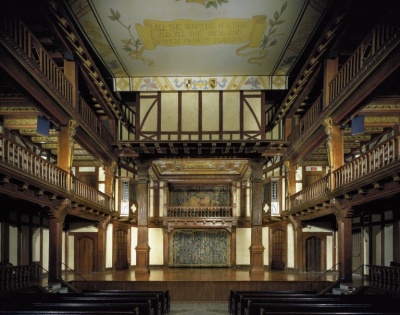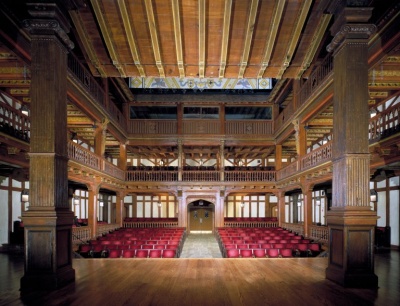Elizabethan Theatre: Difference between revisions
mNo edit summary |
SophieByvik (talk | contribs) mNo edit summary |
||
| Line 1: | Line 1: | ||
''"[The Folger boasts] a reconstruction of an Elizabethan playhouse stunningly contrived to stage plays with the old atmosphere but with all modern appliances."'' –''The New York Times'', April 24, 1932 | |||
The intimate Elizabethan Theatre is the setting for [[Folger Theatre]] productions, early-music concerts by [[Folger Consort]], [[PEN/Faulkner]] lectures and readings, the [[O.B. Hardison Poetry Series]] and programs, family activities, and many education programs, including the Folger’s student performance festivals. | |||
With its three-tiered wooden balconies, carved oak columns, and half-timbered facade, the Theatre evokes the courtyard of an English Renaissance inn. Overhead, a canopy represents the sky. In Shakespeare’s day, such inns sometimes served as playhouses for traveling groups of players, who performed on a raised platform at one end while spectators gathered in the yard and on the balconies above. | |||
[[File:003247.jpg|400px|left|Stage view]] | [[File:003247.jpg|400px|left|Stage view]] | ||
[[File:003249.jpg| | [[File:003249.jpg|400px|right|Audience view]] | ||
| Line 10: | Line 24: | ||
===History=== | ===History=== | ||
Revision as of 21:20, 9 September 2014
"[The Folger boasts] a reconstruction of an Elizabethan playhouse stunningly contrived to stage plays with the old atmosphere but with all modern appliances." –The New York Times, April 24, 1932
The intimate Elizabethan Theatre is the setting for Folger Theatre productions, early-music concerts by Folger Consort, PEN/Faulkner lectures and readings, the O.B. Hardison Poetry Series and programs, family activities, and many education programs, including the Folger’s student performance festivals.
With its three-tiered wooden balconies, carved oak columns, and half-timbered facade, the Theatre evokes the courtyard of an English Renaissance inn. Overhead, a canopy represents the sky. In Shakespeare’s day, such inns sometimes served as playhouses for traveling groups of players, who performed on a raised platform at one end while spectators gathered in the yard and on the balconies above.
History
Include a brief history of the Elizabethan Theatre.
Puck statue
In the lobby just outside the Theatre, visitors are greeted near the door by a marble statue of Puck, Shakespeare’s mischievous sprite from A Midsummer Night's Dream. This is the original statue created for the Folger grounds by the award-winning sculptor Brenda Putnam in 1932 and restored in 2001. Today, an aluminum replica presides over the Folger’s outdoor fountain.
Ceiling paintings and decorations
"The little ceiling in the entry of the theatre is made up of the coats of arms of some people who were either patrons of Shakespeare, or who contributed to the support of some of the players companies for which Shakespeare either wrote, or in which he acted. The stage ceiling is developed from the coat of arms, the crest and supporters of Queen Elizabeth.... The details of the decorations on the beams and rafters were developed mostly from English mediaeval wood-carving, particularly the birds in one of the upper galleries, which design was found on an old English chest. The detail of the small entry ceiling was inspired by painted cartouches on the ceiling of the old Bodleian Library in Oxford."
–Austin Purves, Jr., Artist responsible for the painting, from a letter dated June 1, 1932
Virtual tour
A virtual tour of the Folger's Elizabethan Theatre is available online on both high and low bandwiths.

